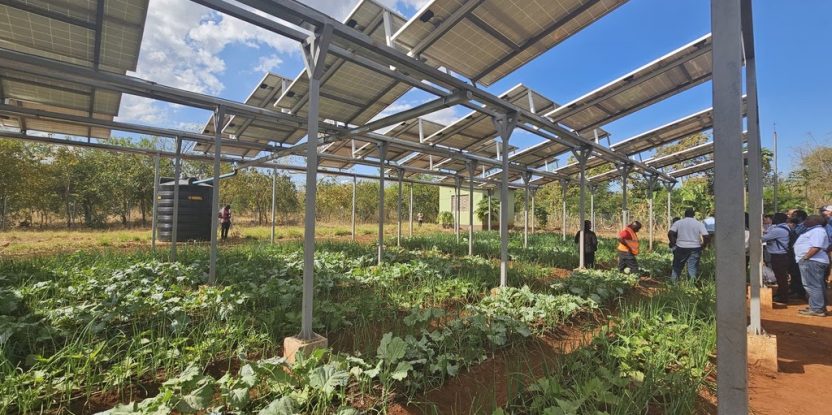
Solar power is emblematic of the transition to greener energy generation, and offers especially critical on- and off-grid options for the planet’s rural communities – 73 percent of which still lack reliable electricity.
Yet conventional solar set-ups have been criticized for taking up land that could otherwise be used for agriculture, thus affecting incomes from crop production, enhancing food insecurity, and incentivizing some farmers to encroach on forested lands to grow what they need.
Agrivoltaics – a new technology that delivers power, crop production, and rainwater harvesting all in the same place by combining agriculture with photovoltaics (panels that convert sunlight directly into electricity) – offers an exciting win-win.
In such a system, the panels can be installed several metres above ground, so farmers can grow and harvest crops and/or graze livestock underneath them. Shade from the panels reduces heat stress and water loss, which can boost productivity, cut irrigation needs, and allow farmers to extend their range of crops and animals.
East Africa stands to benefit particularly highly from the approach: the region gets a lot of sunlight, struggles in many areas with water scarcity and food insecurity, and has relatively low levels of electrification in rural communities. With funding from the United Kingdom’s Global Challenges Research fund (UKRI-GCRF) and the University of Sheffield, an international research partnership between universities in the UK, the Centre for International Forestry Research and World Agroforestry (CIFOR-ICRAF), and local organizations in Kenya, Tanzania and Uganda was formed to explore the potential of agrivoltaics in East Africa.
Working with African solar developers and a Kenyan agribusiness company, as well as non-governmental organizations, regional political organizations, local communities and workers, the researchers established two project implementation sites in semi-arid parts of Kenya and Tanzania with Latia Agribusiness Solutions and Sustainable Agriculture Tanzania, respectively.
In July 2023, CIFOR-ICRAF hosted a learning event in Nairobi to bring together stakeholders across the energy and agricultural sectors to share results from the two pilot systems and explore potential barriers and solutions to increasing uptake of agrivoltaic systems in the region.
In both sites, the farms reported increased yield of some crops, particularly shade-tolerant leafy vegetables, under the shade of the agrivoltaics. “We saw yields of swiss chard and soya beans nearly double compared to the control [full sun] plots!” said Christine Lamanna, a climate change decision scientist at ICRAF who is involved in the project. “Sun-loving crops, like tomato, eggplant and bell pepper either had no change or a decrease in yield in the shade. But surprisingly, we saw consistent, small increases in yield of maize in the partial shade of the agrivoltaics.”
The crops also needed less water for irrigation than those grown in full sun – an average reduction of 15 percent – resulting in significantly higher water-use efficiency for crops such as maize, beans, and greens in the agrivoltaics system.
Despite the promise of agrivoltaics, there are also significant barriers to its uptake. One such barrier participants of the Learning Event identified is access to the capital and skills to set up and maintain an agrivoltaic system. Agrivoltaic systems, like all solar projects, have significant up-front costs, which are often difficult for farmers to meet. To overcome this barrier, participants suggested that farmers could form cooperatives or switch to higher value crops to increase profitability, while the government could support with subsidies or other innovative financing mechanisms to help bring costs down.
The multifaceted nature of agrivoltaics also poses interesting questions for policymakers: since it sits between a number of policy arenas (namely agriculture and energy), there is a risk that no-one takes ownership of developing and implementing the systems. “This intersectoral nature makes it challenging, but also really exciting for finding synergies between development objectives,” said Lamanna.
On the second day of the learning event, participants visited the Latia Agribusiness site to get a hands-on tour of the agrivoltaics system. Participants were welcomed by the Kajiado County Government, as well as hosts Latia Agribusiness Solutions and solar developer Chloride Exide. In addition to the benefits to crops mentioned above, they learned that the setup had led to significant savings on energy bills. Even though the system at Latia is grid-tied and does not have batteries to store energy, the farm is still offsetting more than half of its electricity costs from the agrivoltaics system.
A key takeaway from the learning event was that despite the barriers to uptake of agrivoltaics, there are many potential opportunities for its use in East Africa – from agribusinesses, to farmers cooperatives, to livestock production and even refugee settlements. “We came away from the day with lots of new partnerships and ideas for expanding the triple impact of this approach for food, water, and energy security in African farming systems,” said Lamanna.
Acknowledgements
This learning event was hosted by the Center for International Forestry Research and World Agroforestry (CIFOR-ICRAF) and funded by the United Kingdom’s Global Challenges Research Fund (UKRI-GCRF) and The University of Sheffield, with support from Chloride Exide Limited, SEI – Stockholm Environment Institute, African Centre for Technology Studies (ACTS), Center for Research in Energy and Energy Conservation (CREEC), the University of Arizona, the University of York, Teesside University, and other partners.
We want you to share Forests News content, which is licensed under Creative Commons Attribution-NonCommercial-ShareAlike 4.0 International (CC BY-NC-SA 4.0). This means you are free to redistribute our material for non-commercial purposes. All we ask is that you give Forests News appropriate credit and link to the original Forests News content, indicate if changes were made, and distribute your contributions under the same Creative Commons license. You must notify Forests News if you repost, reprint or reuse our materials by contacting forestsnews@cifor-icraf.org.